
(Click on any image below for a larger version)
Wednesday, January 24: Antarctic Peninsula
The Hanseatic sailed out of Andvord Harbor and past the entrance to Paradise Bay. In February 1999, the Hanseatic struck its starboard propeller in Paradise Bay and had to return to Ushuaia using just one propeller.
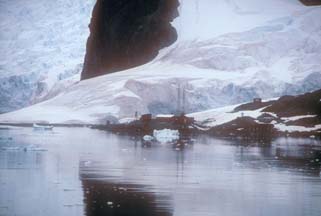 The orange huts of an Argentine
research station could be seen on Waterboat Point near the mouth
of the Harbor.
The orange huts of an Argentine
research station could be seen on Waterboat Point near the mouth
of the Harbor.
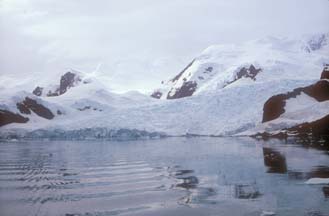 We crossed
the Gerlache Strait and rounded the north end of Wiencke Island.
We crossed
the Gerlache Strait and rounded the north end of Wiencke Island.
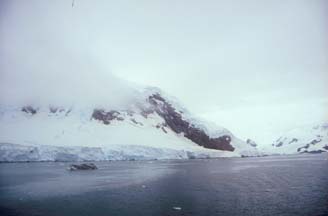 The ship
entered the Neumayer Channel, between Wiencke Island and Anvers
Island.
The ship
entered the Neumayer Channel, between Wiencke Island and Anvers
Island.
We passed a Chilean research station, which has been reoccupied after a period of abandonment. Gentoo Penguins took over the island during the period of abandonment, and the current rules of behavior in Antarctica don't permit the Chileans to clear them out again.
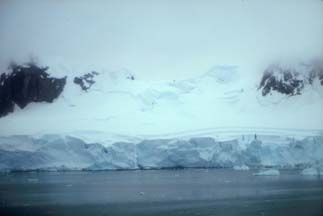 We saw the
last of the sun as the ship negotiated through the winding
narrows of the Neumayer Channel.
We saw the
last of the sun as the ship negotiated through the winding
narrows of the Neumayer Channel.
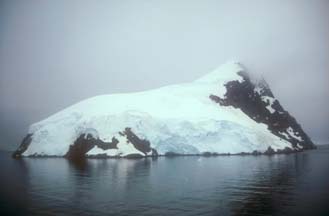 A low
overcast hung over the cold, bleak landscape.
A low
overcast hung over the cold, bleak landscape.
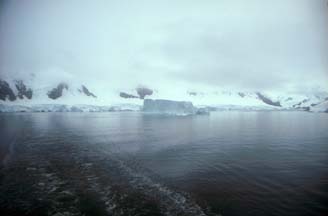 We exited
Neumayer Channel and entered the Bismark Strait.
We exited
Neumayer Channel and entered the Bismark Strait.
After crossing the Bismark Strait near the mouth of Flandres Bay we entered the Lemaire Channel, which lies between the Antarctic Peninsula and Booth Island. We passed Hovgaard Island and dropped anchor just off the coast of Petermann Island.
Petermann Island was the farthest south that our expedition reached. The latitude was 65 degrees, 7 minutes south. The longitude was 64 degrees, 8 minutes west. We had not quite reached the Antarctic Circle.
The air temperature was about 33 degrees F. The water temperature was about 33 degrees F. It was raining. The rain was moving horizontally in the wind. The temperature of the rain was about 33 degrees F.
Sometime earlier in the voyage, I had contracted the most objectionable influenza that I have experienced in at least five years. Looking outside the stateroom window, through the horizontal, near freezing rain, at another mound of rocks with penguins shitting on it, I decided to give Petermann Island a miss.
I watched from the observation deck as Debbie went down to the lockers, donned her wellies, and boarded a Zodiac for the ride to shore. The rain had turned to snow. Big, fluffy snowflakes crackled as they hit the side of the antennae housing. Snow was accumulating on all the exposed surfaces. There were not so many passengers getting off the ship for this landing. Many of the Zodiacs left with just a few people on board.
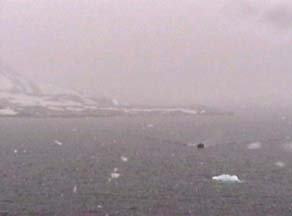 Debbie
returned after a somewhat shorter time than we had spent at the
earlier landings.
Debbie
returned after a somewhat shorter time than we had spent at the
earlier landings.
Debbie informed me that my size 13 wellingtons were no longer in our locker. I went down to see for myself, and indeed, they were nowhere to be seen. Someone had made off with them. I suspected incompetence rather than malfeasance.
We had still another landing to make that day. I was going to need a pair of wellies if I wanted to get onshore again. A short while later I passed the diminutive Gabriel in the hallway. Gabriel had been handling the original distribution of wellies. I asked if there were any other size 13 wellies available. She said it might be a problem to find some.
Later, during the pre-dinner cocktail party, Gabriel found me and told me that she had put another pair of size 13s in my locker.
As we dined, Captain Notke steered the Hanseatic through the Peltier Channel to Port Lockroy. The channel is just a few hundred feet wide and has a very sharp turn of nearly 180 degrees. The ship moved very slowly as it slid around the tight, left-hand turn.
Although dinner was served earlier than usual that night, it was the usual leisurely service. My group was the first to go onshore, and the disembarkation time arrived while I was waiting on desert. I excused myself from the table and hustled off to the room to bundle up for the landing at Port Lockroy.
Port Lockroy was a British Antarctic Expedition research station that was abandoned for nearly thirty years. In 1997 it was restored as a museum of Antarctic exploration. There is a small contingent living there, and it is the most visited attraction in Antarctica. They get about 7,000 visitors a year.
The station sits on the high point of tiny Goudier Island in Peltier Channel. It is covered by Gentoo Penguins and Gentoo Penguin guano.
They have a shop set up in one room of the station where they sell books, maps, first-day postal covers, stamps, and T-shirts with penguins on the back. I had a stack of postcards prepared. I waited in the line in the cramped, dark, and musty old building to get into the little shop. I picked out a pair of the T-shirts, a map of the Antarctic Peninsula, and enough stamps for all my post cards.
I worked my way out past the line of people who wanted to buy stamps, maps, and T-shirts. I found a counter in the dimly lit coal bunker, licked each of the stamps, and pressed them onto the post cards. I placed the stack of post cards into a red Royal Mail box mounted on the wall just inside the entrance to the station.
Then I decided that I would probably need more souvenir T-shirts, so I got back in line to do more shopping. I picked up a medium and two large T-shirts and a book of Antarctic photographs.
The topography of the island was nearly as crowded with stumbling tourists as with Gentoo Penguins. People were wandering about the landscape taking pictures and shooting videotape of the penguins with their chicks.
As I stepped around a couple of German girls from the ship's staff who were standing on the boardwalk that surrounded the buildings, my foot started sliding on the accumulated guano. I went all the way down, landing hard on my left knee. Immediately, I attracted more attention than I wanted from the staff people, all checking to see if they had an injury to deal with. I demonstrated that all my joints were still operating and fended them off.
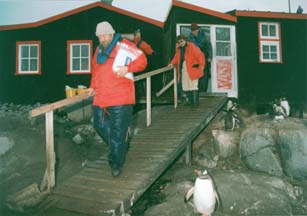 The ship's
photographer was waiting at the bottom of the ramp to the
entrance of the station to shoot pictures of all the passengers
returning with their souvenirs.
The ship's
photographer was waiting at the bottom of the ramp to the
entrance of the station to shoot pictures of all the passengers
returning with their souvenirs.
The path back to the Zodiac was just wide enough for one way traffic, and there was a constant stream of new arrivals coming up from the landing.
The clouds were breaking up overhead as the sun set after 10:00 P.M. It didn't get dark all night. The ship slipped back through the Neumayer Channel and up the Gerlache Strait during the night.
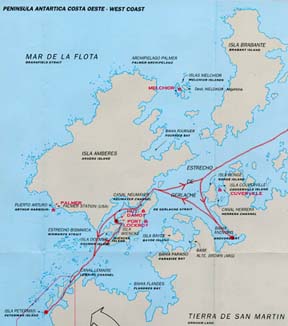 Map of the West Coast of the
Antarctic Peninsula.
Map of the West Coast of the
Antarctic Peninsula.
 Table of
Contents
Table of
Contents Send a message to Brian.